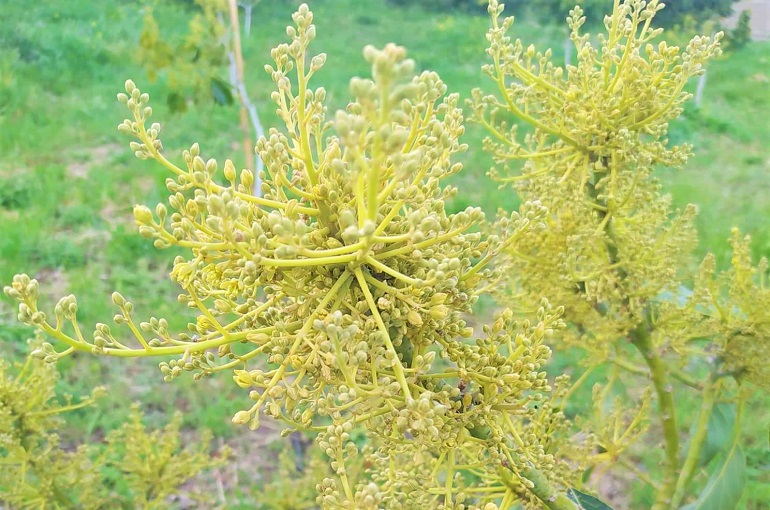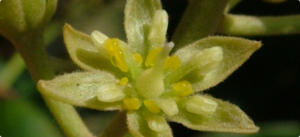Avocado Tree Propagation and Pollination

This post is also available in:
This post is also available in:
![]() Español (Spanish)
Español (Spanish) ![]() Français (French)
Français (French) ![]() Deutsch (German)
Deutsch (German) ![]() हिन्दी (Hindi)
हिन्दी (Hindi) ![]() العربية (Arabic)
العربية (Arabic) ![]() Türkçe (Turkish)
Türkçe (Turkish) ![]() 简体中文 (Chinese (Simplified))
简体中文 (Chinese (Simplified)) ![]() Ελληνικά (Greek)
Ελληνικά (Greek) ![]() Português (Portuguese (Brazil))
Português (Portuguese (Brazil))
Avocado Tree Propagation
After selecting the desirable avocado variety to cultivate, the farmer needs to obtain the appropriate amount and type of reproduction material to plant. Avocados can be propagated by planting seeds, cuttings, grafting and layering. Usually, grafted seedlings are the more common propagation material used for commercial cultivation. Grafted seedlings offer the significant advantages of uniform and accelerated growth and higher yields, which is why we prefer them as a starting material in our orchards.
Propagation of Avocado Trees Grafted on seedling rootstocks became a more common technique mainly after the root rot disease incited by Phytophthora became economically important. Moreover, the use of resistant rootstocks became handy in many other cases. For example, avocado is extremely sensitive to salinity (especially the Mexican race), alkaline conditions, lack of aeration (heavy soils), poorly drained soils, and lime-induced chlorosis. To overcome all these and grow popular, but sensitive, avocado cultivars in various soils and environments, most farmers prefer to use grafted plants on resistant rootstocks (1).
Producing avocados from seeds usually takes place in the nursery, but there are cases a smallholder or an amateur farmer can perform it. For a higher success rate, the seeds that will be used must be collected from ripe, healthy fruits still attached to the trees. As a next step, the seeds should be properly stored (if you intend to plant them later) or treated in a water bath for 30 minutes (50oC or 122oF). After the treatment, the seeds need to be cooled down and dried. Different substrates (potting mixes) can be used to plant the avocado pit, such as mixes of 3 parts peat moss to 2 parts perlite or 1/3 peat, 1/3 perlite, and 1/3 vermiculite. We can remove the seed coat and place the seed with the apical end at the surface of the potting mix. If temperature and soil moisture are at appropriate levels, germination is expected within 4 weeks. Some of the most widely used varieties as seedlings belong to the Mexican race (Topa-Topa, Mexico, Mexicola). Keep in mind that the farmers must purchase this material from a certified plant nursery.
As mentioned before, the avocado trees will carry some specific characteristics depending on the race chosen to be used as rootstocks. On a large scale, the Mexican race is considered one of the most popular rootstocks used for cultivation in regions like California, Israel, and South Africa. West Indian stocks are preferred in warmer regions or where salinity is a problem. At the same time, the Guatemalan race is mainly used in warmer climates and field neutral pH and has no problems with Verticillium wilt (2). Nowadays, scientists concentrate their efforts on finding and breeding avocado varieties tolerant to climate change effects, like drought. These varieties will then be used as rootstocks to cultivate important commercial varieties across the globe.
Pollination of Avocado trees
Even in ideal conditions, from the million greenish-yellow flowers produced per plant, only a few are fertilized and will produce fruits. Even though avocado has perfect, bisexual flowers (that have both male and female organs), the self-fertilization is not sufficient to produce enough (or any) fruits. The reason behind this “malfunction” is the unique flowering behavior of the avocado trees, known as “protogynous dichogamy,” which leads to categorizing all varieties into 2 group-types, based on the moment that the flowers will become reproductively functional as males or females. In this scheme, self-fertilization happens during the second opening of the flowers within the day. However, usually, cross-pollination is needed to increase fruit production (3).

https://www.agric.wa.gov.au/spring/cross-pollinisers-hass-avocado
To manage that, we selected to cultivate in the same field two varieties of avocado, one from each type. This allows us to have an overlapping flowering of mature male and female flowers from type A and B plants and successful fertilization. We use Hass as a “pollinizer” variety since we cultivate two type B varieties (Fuerte and Zutano) and one type A variety (Hass). By placing two Hass trees every 20 plants of the type B varieties, we have seen that we gain the desired result. The “pollinizer” are usually placed at key spots to benefit from the wind drift. While it is generally advised to have a 1:1 or 1:2 proportion of the plants of different types, our plants give medium to high yield. We speculate that the main reason for this is the small size of our fields (2-3 stremmata, 0.2-0.3 hectares) and the neighboring with other avocado fields.
The classification of the most important commercial varieties into the two types can be seen in the following table.
| “A type” varieties | “B type” varieties |
| Hass | Fuerte |
| Gwen | Zutano |
| Lamb | Bacon |
| Pinkerton | Ettinger |
| Reed | Sharwil |
| GEM | Sir Prize |
| Harvest | Walter Hole |
| Wurtz | Edranol |
| Rincon | Nabal |
| Anaheim | Nobel |
| Benic | Booth3,5,7,8 |
| Dickinson | Abobodo Mabal |
| Duke | Pollock |
| Mexican August | |
| Yama |
However, there are also some exceptions with varieties such as “Waldin,” “Lula,” and “Taylor” that fruit well when planted alone, since self fertilization happens at a good level. Finally, scientists suggests that since avocado is mainly pollinated by bees, the farmer can introduce some beehives to his/her field during the flowering period (4, 3). At least 10 bees per tree are needed (6). Cross-pollination works better in temperatures around 20-24 oC (68-75 oF), while avocado fruit set is favored at 18-24 oC (65-75 oF) .
High temperatures (over 38-40 oC) or/and strong warm winds during flowering are the main problem that most farmers experience and can cost them their production (yield decrease up to 70%). Extended problems and yield losses due to heat can occur in the fruit developing stage. Young fruits are more sensitive, and their temperature can increase dramatically. In this case, they become soft and they are no longer viable. Some research results mention that there is a risk of quality deterioration under such conditions since the composition of the various oils in the avocado can be affected (5). We advise the farmer to leave sufficient leaf area after the yearly pruning to protect the fruits from sunburn. Together with some other farmers, we have obtained some good results by applying Zinc Chelate products to our plants during flowering, when the temperature is dangerously high (summer period).
References
- http://www.avocadosource.com/journals/horticulturalreviews/hortrev_1995_pg_381-429.pdf
- https://www.fao.org/3/X6902E/x6902e06.htm
- https://www.kalro.org/sites/default/files/avocado-production-cultivation.pdf
- https://www.agric.wa.gov.au/spring/growing-avocados-flowering-pollination-and-fruit-set
- https://www.californiaavocadogrowers.com/cultural-management-library/managing-avocado-heat-damage
- https://www.californiaavocadogrowers.com/cultural-management-library/spring-pollination-avocado-groves
History, Nutritional Value and Plant Information of Avocado
All Avocado Varieties Explained- Characteristics and Advantages
Avocado Tree Climate and Soil Requirements – Planting Avocado Trees
Avocado Tree Propagation and Pollination
Avocado Tree Water Requirements and Irrigation Systems
Avocado Fertilizer Requirements
Training and Pruning of Avocado Tree
Avocado Harvest, Yield per hectare and Storage








































































